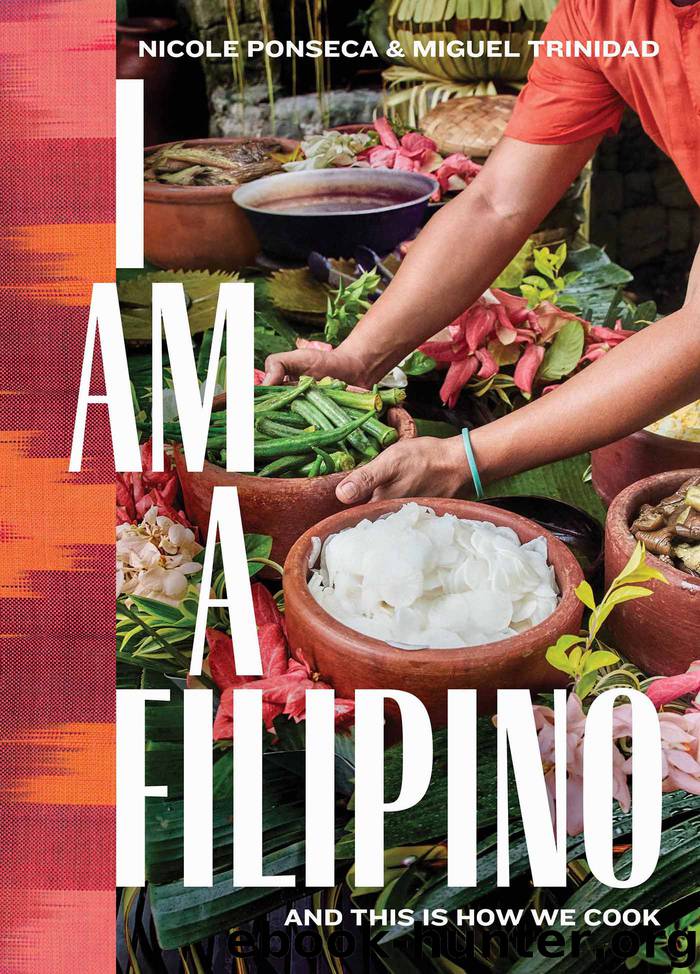I Am a Filipino by Nicole Ponseca

Author:Nicole Ponseca
Language: eng
Format: epub
Publisher: Artisan
Published: 2018-10-15T17:29:09+00:00
Filling and Forming Molo Dumplings
Chicken Stock
This deeply flavored stock is rich with collagen thanks to the chicken bones and will improve almost any recipe that calls for chicken stock, though you can of course use store-bought or bouillon cubes in a pinch. Makes 8 cups (2 L)
5 pounds (2.3 kg) chicken bones (see Note)
1 large carrot, halved
2 celery stalks, each cut into 3 pieces
2 large white onions, quartered
2 teaspoons whole black peppercorns
4 bay leaves
¼ cup (10 g) cilantro stems
Preheat the oven to 350°F (175°C).
Place the chicken bones on a rimmed baking sheet and roast, turning them occasionally with tongs, until they are nicely browned on all sides, about 1 hour. Drain off any fat that may have accumulated in the pan and reserve it for another use, such as for roasting vegetables or making fried rice.
Transfer the bones to a large stockpot and add the carrot, celery, onions, peppercorns, bay leaves, cilantro stems, and 5 quarts (5 L) water. Bring to a boil over high heat, then reduce to medium-low so the stock cooks at a simmer. Simmer for at least 2 hours and up to 3 hours.
Strain the stock through a fine-mesh sieve, discarding the solids. Store the stock in airtight containers in the refrigerator for up to 1 week or in the freezer for up to several months.
Note: You should be able to get chicken bones from any butcher, though you will likely need to call ahead. A little meat left on is fine. You can also use bones left over from roasted, fried, baked, or any other chicken dish—you can keep them tightly sealed in the freezer until you collect enough to make the stock.
Molo, the part of Iloilo City on the southeastern tip of Panay Island, was once a parián, an area where all the Chinese in the region were forced to live. Like Binondo, the Chinatown in Manila, it is a place where it’s easy to see the imprint of Chinese culture on Philippine architecture, cuisine, and commerce. Some Chinese eventually intermarried and moved out of Molo and into the rest of Iloilo City, many becoming part of the city’s upper class. Today, remnants of that community still stand, including fantastic dishes heavily influenced by the early Cantonese settlers, not to mention a few incredible (though fading) Chinese-influenced mansions hidden behind modern buildings.
Download
This site does not store any files on its server. We only index and link to content provided by other sites. Please contact the content providers to delete copyright contents if any and email us, we'll remove relevant links or contents immediately.
Biscuits: A Savor the South Cookbook by Belinda Ellis(4290)
The French Women Don't Get Fat Cookbook by Mireille Guiliano(3606)
A Jewish Baker's Pastry Secrets: Recipes from a New York Baking Legend for Strudel, Stollen, Danishes, Puff Pastry, and More by George Greenstein(3545)
Better Homes and Gardens New Cookbook by Better Homes & Gardens(3525)
Ottolenghi Simple by Yotam Ottolenghi(3517)
Al Roker's Hassle-Free Holiday Cookbook by Al Roker(3499)
Trullo by Tim Siadatan(3380)
Bake with Anna Olson by Anna Olson(3357)
Hot Thai Kitchen by Pailin Chongchitnant(3320)
Panini by Carlo Middione(3252)
Nigella Bites (Nigella Collection) by Nigella Lawson(3173)
Momofuku by David Chang(3140)
Salt, Fat, Acid, Heat: Mastering the Elements of Good Cooking by Nosrat Samin(3108)
Modern French Pastry: Innovative Techniques, Tools and Design by Cheryl Wakerhauser(3076)
Best of Jane Grigson by Jane Grigson(2947)
Classic by Mary Berry(2942)
Solo Food by Janneke Vreugdenhil(2930)
Tapas Revolution by Omar Allibhoy(2929)
Ottolenghi - The Cookbook by Yotam Ottolenghi(2871)
